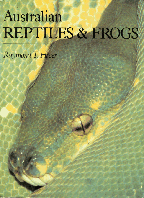 HANDLING REPTILES AND FROGS.
HANDLING REPTILES AND FROGS.
When handling reptiles and frogs the two main considerations are the welfare of the animal and ones' own personal safety.
Handling of any newly caught Herptile (Reptile or frog) should be kept to a minimum, as excessive handling may distress or physically harm the animal. Frogs have a soft permeable skin, and may actually be burnt by the warmth of human hands. Humans may occasionally suffer skin reactions from the secretions of frogs. All herptiles should be handled gently but firmly, and with support given to the body, and they should never be allowed the chance to escape through loose grip on the part of the handler. The grip of the handler should be such that the herptile is unable to change its' positioning in any way. Otherwise the handler is at risk, and that is not an aceptable situation.
Most lizards have the ability to shed their tails, (Autotomy) and this should be prevented at all costs; for a number of reasons. Therefore it is advisable to never tail handle any lizard. Also if a lizard is trying to 'throw' its' tail around when being handled, this should be brought under control.
In most cases any reptile that is likely to give a painful or poisonous bite should be firmly held behind the head so that it cannot turn around and bite the handler. Snakes are first pinned by the head on the ground with a jigger stick before being picked up by the handler by the back of the head. Gloves should not be worn by reptile handlers as the sensitivity lost through the gloves actually increases the risks of a bite, through possible 'bad handling'.
Some poisonous snakes may be tail handled due to the difficulty of grabbing them behind the head. In this case the snake is grabbed by the tail and its' body is twisted constantly so that the snake is always out of balance and therefore unable to rise up and bite the handler. Usually most venomous snakes are handled in this manner and then 'thrown' into an open bag which is then rapidly closed and sealed, when first caught in the wild.
Hooks which are often used to lift and carry venomous and other snakes in captivity are useful in that they minimize contact between handler and snake, thereby minimizing the risk of a bite.
Lizards with sharp claws, such as monitors should be held away from ones' own body so that they don't scratch one severely. Larger lizards are capable of drawing blood with their claws. Long muscular whip-like tails of larger monitors and some agamids can also cause problems and should therefore always be held away from the face and other sensitive areas.
Testudines generally pose no handling problems although the jaws of larger specimens should be watched closely.
Medium to large crocodiles should be handled by more than one person, and often need to be 'roped' or tied up before actually being handled. They have large powerful potentially destructive tails, not to mention their jaws. Captive specimens are often more dangerous than wild specimens.
To continue to the rest of this section

The above was from the book Australian Reptiles and Frogs by Raymond Hoser and now available on a fantastic CD-Rom along with a vast amount of other information, papers and the like on reptiles, frogs and other wildlife.